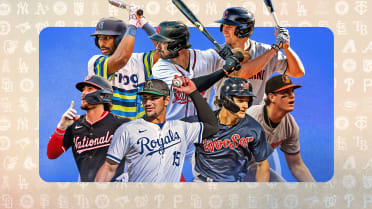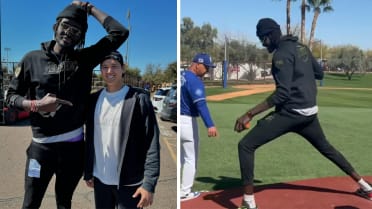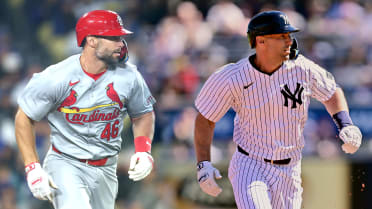Best duo ever? Judge-Soto rising to great heights
In baseball history, there are certain iconic lineup duos whose names stand the test of time. Ruth-Gehrig. Aaron-Mathews. Mays-McCovey. Biggio-Bagwell. The list continues.
Whether the pairing of Judge-Soto one day ascends to that level of baseball immortality depends heavily on what will happen this coming winter. Aaron Judge's Yankee pinstripes are drawn in permanent marker. But Juan Soto is a pending free agent -- one of the most highly anticipated free agents we’ve ever seen. Should Soto depart the Bronx after his sensational 2024, then historically speaking, his partnership with Judge will amount to more of a blip than an Earth-shaking event.
But oh, what a blip.
Right now, we don’t know the future. We don’t know whether Judge-Soto will become synonymous with each other like those names mentioned above. What we do know is what has happened over roughly the first five months of the 2024 season, and that is pretty special on its own. In fact, it’s nearly unprecedented.
By themselves, Judge and Soto are making history. Together? They are on their way to becoming an inner-circle, all-time great lineup pairing, in terms of single-season productivity.
There is some history of teammates placing 1-2 in the MVP Award voting, but that's not quite what we're after here. (And Bobby Witt Jr. seems likely to throw a wrench in that, anyways.) So let's dig further into the numbers and find out just how rare it is to have two titans like this joining forces to such a dominant degree.
PURE POWER
Judge already has 49 home runs this season and appears primed to challenge his own American League record of 62 set just two years ago. Meanwhile, Soto’s 36th homer of the season, hit Wednesday against the Guardians, pushed him to a new career high of his own. (He hit 35 for the Padres last year and 34 for the 2019 Nationals.) That means just four more Soto homers will give both players 40.
It would be only the 33rd time that two teammates have cracked the 40 mark in the same season, including four instances in which three teammates all did it. One of those came just last year, courtesy of the Braves’ Ronald Acuña Jr., Matt Olson and Marcell Ozuna. The last pair of Yankees to do it? Mickey Mantle and Roger Maris in, yes, 1961.
But we can go a bit deeper than just looking at balls that left the yard. It’s not just the dingers with Judge and Soto – it’s the overall power production. Judge’s slugging percentage is an outrageous .725, which would be the highest by anybody since Barry Bonds. Soto’s .600 SLG seems meager by comparison but is still fourth in the Majors this season. So what if we add a .600 SLG to the mix, along with 40 homers? Now we’re getting somewhere – somewhere we haven’t been in 20 years.
Teammates with 40+ HR, .600+ SLG in a season
- Jim Edmonds & Albert Pujols (STL), 2004
- David Ortiz & Manny Ramirez (BOS), 2004
- Jeff Bagwell & Richard Hidalgo (HOU), 2000
- Ellis Burks & Andres Galarraga (COL), 1996
- Mickey Mantle & Roger Maris (NYY), 1961
- Roy Campanella & Duke Snider (BRO), 1953
- Lou Gehrig & Babe Ruth (NYY), 1927, ’30-‘31
That’s right: It’s happened nine times in the past, and three of those were via Gehrig and Ruth. Well, get used to that.
OVERALL OFFENSE
Home runs are great, and so is slugging, but there is more to offensive production that either or even both. Most notably: Getting on base. And well, it just so happens that Judge (.464) and Soto (.427) are, respectively, first and second in the Majors in terms of on-base percentage. Those are mind-blowing numbers.
Outside of the pandemic-shortened 2020 season, the last time qualified teammates both had OBPs of at least .425 was 2001, and that was when Todd Helton and Larry Walker did it in Colorado. Before that, it happened twice in 1999 (Derek Jeter and Bernie Williams for the Yankees; Manny Ramirez and Jim Thome for Cleveland.) Meanwhile, it’s been 36 years since the last time teammates finished 1-2 in the Majors in that category – in 1988, Boston’s Wade Boggs (.476) and Mike Greenwell (.416) took the top spots.
If we fold together OBP and SLG and adjust for things like ballpark effects and the offensive environment, we get OPS+, a stat where 100 represents league-average offensive production. Judge’s OPS+ this season is 227, which is stratospheric. It would rank 10th in a qualified AL/NL season in the Modern Era (since 1900), behind only guys named Bonds (four seasons), Ruth (three) and Ted Williams (two).
In just about any normal season, Soto’s 184 OPS+ would also be an awe-inspiring and league-leading figure. So let’s break down where the Judge-Soto duo could land historically, in terms of OPS+.
Number of qualified teammate pairs to reach OPS+ threshold in a season
AL/NL players in Modern Era (since 1900), excluding 2020
160 OPS+ or better: 53 (including two trios)
170 OPS+ or better: 10
180 OPS+ or better: 5
190 OPS+ or better: 4
Those numbers are misleading, though, and that’s because of that ultimate one-two combo, Gehrig and Ruth. Those two alone account for eight of the instances at 160-plus (including once when they were joined by Tony Lazerri. Most notably, they account for half of the instances at 170-plus, and all of the instances at both 180-plus and 190-plus.
In other words, if Soto can keep his OPS+ above 180, he and Judge will have accomplished something previously done by only one other pair – and by nobody in more than 90 years (1932).
VAUNTED VALUE
There is one more metric we should bring into consideration here, and that’s Wins Above Replacement (WAR), which incorporates what players contribute not only with their bats, but also their gloves and their legs. That may be a bit beside the point when discussing sluggers such as Judge and Soto – to some extent, they mash enough that they don’t need to do much else. Still, it should be interesting to see where the two of them stack up against duos that perhaps don’t crush the ball as much but also have more well-rounded games.
Going by the WAR figures at Baseball-Reference, Judge’s 9.2 gives him the MLB lead, almost a win ahead of Royals shortstop Bobby Witt Jr. (8.3). Behind them, Soto (7.5) is in a virtual tie with Orioles shortstop Gunnar Henderson and Red Sox outfielder Jarren Duran.
As with OPS+, Judge and Soto together are already in relatively rare (but hardly unheard of) WAR territory. And as with OPS+, a truly elite threshold appears to be well within their reach down the stretch.
Number of teammate pairs to reach WAR threshold in a season
AL/NL position players in Modern Era (since 1900)
7 WAR or better: 72 (including four trios)
8 WAR or better: 18
9 WAR or better: 5
10 WAR or better: 1
Once again, Gehrig and Ruth loom large. They’re the only position player duo to crack 10 WAR apiece (in 1927) and account for three of five instances at 9-plus WAR, along with Cleveland’s Nap Lajoie and Terry Turner (1906) and Seattle’s Ken Griffey Jr. and Alex Rodriguez (1996). They had five seasons at 7-plus WAR, a feat that last occurred in 2011 (Jacoby Ellsbury and Dustin Pedroia for Boston.)
THE FULL PICTURE
Let’s combine what we’ve learned about different metrics, looking at where Judge and Soto might end up by season’s end and just how rare that would be.
Let’s say Soto cools off some down the stretch and has a relatively modest September, finishing with a 170 OPS+ (again, down from 184 currently) and 8 WAR (just .4 above where he is now). Those two numbers alone would put Judge-Soto in a club occupied by only one other duo. You guessed it: Gehrig-Ruth. Those two legends, amazingly, did it five times (1927-28, ’30-’32).
If you figure Soto tacks on four more homers to add 40 homers to the mix, then it’s just three Gehrig-Ruth seasons (1927, ’30-’31) on the list.
Final question: Is there any way for Judge and Soto to post actually-unprecedented numbers? Well, no. Gehrig and Ruth were just that good in 1927.
1927 Babe Ruth: 60 HR, .772 SLG, 225 OPS+, 12.6 WAR
1927 Lou Gehrig: 47 HR, .765 SLG, 220 OPS+, 11.9 WAR
It’s hard to imagine anyone ever topping that. But Judge and Soto are setting an impressive standard of their own.
Now we sit back and watch just how high they can go -- and how long they stick together.
Andrew Simon is an editor and writer for MLB.com.




